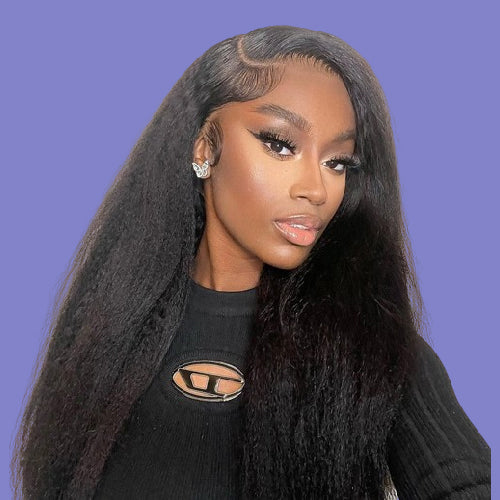Step-by-Step Tutorial: How to Wear a Wig Cap
Achieving a natural, secure and comfortable wig look starts with properly wearing a wig cap. This essential base layer creates an even surface for your wig to lay flat against, preventing irritation to your scalp from the wig rubbing directly against it. A wig cap also helps keep your wig firmly in place without slipping or shifting throughout the day. Whether you wear synthetic or human hair wigs, following the right steps to apply your wig cap is crucial for both enhancing the appearance of your wig and ensuring your own comfort and protection. This step-by-step guide will walk you through the entire process, from preparing your natural hair to positioning and securing the wig cap, as well as covering special considerations like short hair or lace front wigs.
Why a Wig Cap is Necessary

While an extra step, wearing a wig cap is absolutely crucial for the best wig-wearing experience. A wig cap serves several important purposes that shouldn't be overlooked.
1. Creates an Even Surface for Wig Application
Applying a wig directly over your natural hair can result in an uneven, bumpy surface. A wig cap smooths over your hair to create an ideal flat base for your wig to lay seamlessly against.
2. Prevents Scalp Irritation
Wigs rubbing against your bare scalp and hair can cause friction, leading to irritation, discomfort, and even hair loss over time. A wig cap acts as a protective barrier between the wig and your scalp.
3. Maintains Wig Placement and Prevents Slippage
Wig caps are designed to grip the hair close to the scalp for a snug fit. This snug base helps keep your wig anchored in the correct position without sliding or slipping out of place as you move around.
Without a wig cap, you lose the benefits of an even wig surface, scalp protection, and stable wig security. While it's an extra step, taking the time to properly apply a wig cap is essential for achieving the most natural, comfortable wig look possible.
Step-by-Step: How to Apply a Wig Cap Properly
Creating a smooth base by correctly applying your wig cap is crucial for achieving a natural, secure wig look that lasts all day. Follow these detailed steps carefully.
Step 1. Prepare Your Natural Hair
How you prep your natural hair makes a big difference in the overall fit and comfort of the wig cap.
- Long Hair: For long hair past the shoulders, flat cornrow or braid styles that lie flat against the scalp provide the ideal smooth, contained base before putting on the wig cap. Use a rat-tail comb to keep the braids tight and close to your head.
- Short Hair: If you have short hair, use a strong-hold gel like a construction worker styling gel to thoroughly slick down and secure any shorter layers or face-framing pieces before covering with the wig cap. Bobby pins can also help flatten shorter hafts.
- Medium Length: For shoulder-length or medium hair, pull hair into a low, flat ponytail or bun secured tightly at the nape of your neck. Use soft fabric hair ties to avoid bumps.
Step 2. Protect the Scalp
Those with sensitive scalps prone to irritation should apply a protective barrier product before putting on the wig cap. A few options:
- Scalp Oil: Use a lightweight hair oil like argan or jojoba to create a soft buffer between your scalp and the cap material.
- Conditioning Spray: Look for vitamins and silicone in conditioning sprays to nourish and protect your scalp while wearing caps/wigs.
- Wig Cap Liner: These soft mesh cap liners wick away moisture and protect your scalp from friction with the wig cap fabric.
Step 3. Position the Wig Cap
Aligning the wig cap correctly on your head is key. Place the cap's front edge flush against your natural hairline, lying fully flat against your forehead area. Carefully adjust as needed if you have an uneven, curved or high hairline shape in areas like the temples to ensure full coverage.
Step 4. Fit the Cap Over Hair
Once the wig cap is properly positioned at the front hairline, gently stretch and smooth the cap material back over the top and sides of your prepped hair. Use your fingers to carefully tuck and secure all strands fully underneath the cap's interior so no hair is left sticking out. Double check for full coverage, ensuring the cap lays flat over the ears and around the nape area at the back of your neck.
Step 5. Secure the Cap
To keep your wig cap anchored securely in place, use hairpins or wig/lace clips to secure the edges and interior edges. Gently insert a few hairpins around the perimeter of the cap, catching some interior hair to grip the cap tightly against your head. Or you can apply a wig adhesive product along the inside edges of the cap for extra hold - just be very sparing with adhesive amounts.
Taking the time for careful wig cap preparation and application ensures you have the ideal smooth, snug base for your wig to lay flat and natural-looking. It also prevents slipping and increases overall comfort.
Special Considerations for Short Hair

While the basic steps for applying a wig cap are the same for all hair lengths, those with short hair may need to take some extra precautions.
1. Thoroughly Flatten Short Layers
When you have short hair, even just a few inches of length can create bumps and uneven spots under your wig cap if not properly flattened first. Use strong-hold styling products liberally:
- Hair Gels: Apply a generous amount of maximum-hold hair gel from roots to ends on the top and sides of your hair. Use a comb to thoroughly slick it down.
- Pomades: Rub a water-based pomade between your palms and smooth it over the top and sides of your short hair to weigh it down and control any flyaways.
- Hairspray: After using gel or pomade, lock in your smooth look with a heavy hairspray application, allowing it to fully dry before capping.
2. Bobby Pin Short Pieces
For those with very short layers or face-framing pieces, using just styling products may not be enough. Secure these shortest sections with bobby pins or hair clips before smoothing on the wig cap.
Start by spritzing clips with hairspray and then use them to flatten and pin down any short, stubborn pieces along your hairline and nape area. This creates a snag-free base.
3. Consider a Wig Cap Liner
An optional extra step for very short hair is using a wig cap liner or fishnet wig cap first. This lightweight mesh cap goes on first to grip your short hairs, then the wig cap smooths over it.
By taking a little extra time to get very short hair fully flattened and secured first, your wig cap can then lay seamlessly smooth for the perfect wig fit.
How to Wear a Wig Cap with Lace Front Wigs

Wearing lace front wigs, which have ultra-fine lace mesh hand-tied with individual hairs along the hairline, requires some adjustments to your wig cap application technique.
1. Set Wig Cap Back from Hairline
Unlike standard wigs, you'll want to position the front edge of the wig cap slightly behind your natural hairline when wearing a lace front piece. This allows the sheer lace portion to lay flat and seamlessly blend with your skin.
Start by placing the wig cap around 1/4 to 1/2 inch behind your front hairline, aligning the cap edge with where your hair actually starts growing from the scalp. Smooth the cap flat against your head in this set-back position.
2. Secure Just the Interior Edges
Once the front of the cap is positioned behind the hairline area, use wig/lace clips or flat hairpins to securely anchor just the interior edges and sides of the wig cap. Avoid over-securing the front edge against your forehead.
This creates a small open space along the hairline area for the sheer lace front portion to seamlessly blend with your skin tone and natural hair texture.
3. Apply Lace Front First, Then Cap
With just the interior portions of the wig cap secured, you can carefully apply the ultra-sheer lace front section first along your natural hairline. Follow the wig manufacturer's instructions for cutting and customizing the lace to blend with your skin.
Once the lace leading edge is secured, then smooth and position the wig cap over the rest of your head to flatten neatly against the lace front base.
Mastering Wig Cap Application
Properly applying a wig cap is essential for a natural, secure wig look. By prepping your hair, choosing the right cap, positioning it precisely, and taking extra steps for short or lace front styles, you create the ideal smooth base. While it takes some effort initially, mastering this crucial first step allows you to fully enjoy the benefits of wigs - enhanced appearance, scalp protection, and stable placement. With practice, wig cap application becomes second nature, enabling you to confidently rock your wig styles.







Leave a comment